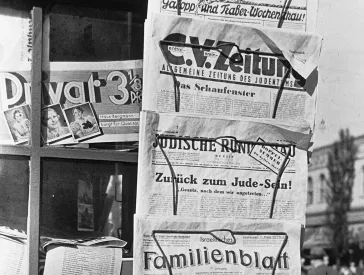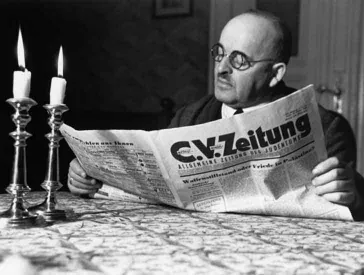GOLEM: Opening of the major exhibition at the Jewish Museum Berlin
Exhibition dates: 23 September 2016 to 29 January 2017
Press Release, Thu 22 Sep 2016
Today, September 23, the Jewish Museum Berlin opens a major exhibition about the golem. This most famous of Jewish legendary figures has inspired generations of artists and authors right up to the present day. The exhibition presents the golem from its creation in a Jewish mystical ritual to its presence in popular storytelling. Seven extensive chapters and an epilogue display stories, objects, and works of art covering a span of 600 years. The centuries-old myth of the golem remains fascinating even today, and has also become a metaphor for modern scientific and political developments that threaten to get dangerously out of control.
Renowned artists such as David Aronson, Fritz Ascher, Christian Boltanski, Yves Gellie, Anselm Kiefer, R.B. Kitaj, Hugo Steiner-Prag, and Charles Simonds have created variations on the golem motif in their works. The 900 m² of the Jewish Museum Berlin’s exhibition bring together loans from important museums and private collections all over the world, including the Jewish Museum New York, the Museum of Fine Arts Boston, the Museum of Modern Art, New York, and the Israel Museum, Jerusalem.
- Contact
-
Press office
T +49 (0)30 259 93 419
presse@jmberlin.de
- Address
Jewish Museum Berlin Foundation
Lindenstraße 9–14
10969 Berlin
The Golem Lives On
"The golem can look back on a long career, in Judaism and far beyond," says Peter Schäfer, Director of the Jewish Museum Berlin. "Its story begins in the Hebrew Bible and continues, in constantly new transformations, into the present day. The ancient human dream of creating artificial beings connects with today’s world: genetic technology and artificial intelligence, computers and robots. All these are endeavors to create a kind of golem."
Every generation makes its own golem, to mirror its own needs, anxieties, and hopes for redemption. The exhibition begins in the present day. Right away, in the entrance area, it demonstrates how omnipresent the golem remains today. As a motif and metaphor, the modern golem stands for uncontrollable progress that may unleash primal fears. It symbolizes the ambivalence of optimism and skepticism toward the achievements of an increasingly technologized world. Humanoid action figures, cyborgs, and robots populate the cosmos of role-playing and computer games as the golem’s modern descendants. Artificial creatures, they obey the commands of their creators – but the potential to run out of control is always lurking within them.
Jewish Mysticism
A separate chapter explores the origins of the golem legend. Medieval manuscripts containing "recipes" for creating a golem are juxtaposed with contemporary artworks. Jewish mystics of the Middle Ages saw the creation of a golem as an attempt to get closer to God. Formed out of dust or earth (in Hebrew, golem means "unfinished substance"), the golem was awakened to life through incantations, ritual acts, and particular combinations of Hebrew letters. The process of creation itself was more important than any practical purpose to which the golem could be put. The artworks of David Aronson, Lynne Avadenka, and Joshua Abarbanel address aspects of this mystical tradition.
Transformation: Art as an Act of Creation
Processes of transformation are at the heart of the golem motif. For artists, the golem acts as a metaphor for creativity and the process of animating inanimate matter. This core idea gives birth to works of art concerned with the process of becoming. As soon as the artwork is completed, it escapes the control of the artist, just as the golem escapes its creator. Artists deploy a wide diversity of techniques and media to give visibility to these processes of transformation. For example, Michael David deliberately exposes his work to fire and other forces of nature, which change his large-format pieces repeatedly over long periods of time. David Musgrave uses trompe l’oeil techniques to explore the ways in which materials are transformed in the process of making art.
Legendary Prague: The Myth Continues
No other location is so closely associated with the golem legend as Prague, to which two rooms in the exhibition are dedicated. The legend crystallizes around the sixteenth-century Rabbi Judah Loew, who is said to have created a golem out of clay in the hope that it would help protect the Jewish ghetto against persecution. The perpetuation of the legend was favored by the fertile spirit of a period inspired by alchemy and astronomy, magic and the occult. Evidence of this intellectual atmosphere is Emperor Rudolf II’s Wunderkammer, or cabinet of curiosities, which visitors can discover as a virtual installation using 3D glasses. The myth of the Prague golem continues to this day, with many historical sites in the city. These appear in the exhibition in historical photographs, drawings, and the lithographs of Hugo Steiner-Prag.
Horror and Magic
The actor and director Paul Wegener was uniquely influential in shaping the image of a clumsy, robot-like golem. Wegener’s cinematic masterpiece The Golem, How He Came into the World of 1920 is considered a milestone in the horror genre. The film left its mark on many different incarnations of the golem or related figures, from the classic Frankenstein (1931) to the Simpsons episode You Gotta Know When to Golem (2006). In this chapter, the best-known film adaptations of the golem legend emphasize the threatening and monstrous aspects of the figure. Movie clips, film posters, and sketches for Hans Poelzig and Marlene Moeschke’s three-dimensional film sets are shown. The three-channel film installation AE/MAETH by Stefan Hurtig and Detlev Weitz, based on clips from more than sixty feature films, plays in a separate space as an eight-minute loop.
Out of Control: The Golem as Protector and Destroyer
A crucial question around which many golem portrayals revolve is whether the golem can be described as a human being, and if so, in what sense. Certainly, it is alive, but it has no will of its own and only executes the orders of its creator. In many golem stories, this superhumanly powerful creature gets out of control. Designed to be a helper or rescuer, it now becomes a threat to the one who created it. This makes the golem a metaphor for the challenges facing modern society. We benefit from many modern developments, but will we be able to control them? Or do they control us? The exhibition explores the responsibility borne by creators and the interplay between power and salvation. This continuation of the narrative is reflected in exhibition objects and recordings of international theatrical productions.
Doppelgänger and Epilogue
The last chapter and the epilogue lead visitors back into the present day and confront them with visions of the future. The golem figure is frequently associated with the many-faceted motif of the doppelgänger: the golem as an alter ego that gives form to hidden longings. Disturbing doppelgänger motifs from robot laboratories are presented in this chapter, including Yves Gellie’s series of large-format photographs showing the Japanese scientist Hiroshi Ishiguro with his mirror image, the robots Geminoid H1 to IV. Gellie explores the borders between man and machine, asking what constitutes the essence of humanity. In the Epilogue, visitors encounter interactive and playful elements, game consoles, the Comic Lounge featuring comics as original editions and on tablets, a Minecraft game station, and a face morphing station where visitors can guide the expressions of a golem face. The closing motif of the exhibition, covering an entire wall, is the scenery of the production Golem by the London-based theater company 1927 (dir. Suzanne Andrade/Paul Barritt). This production set offers a glimpse into a future when everyone will carry a golem in their ear and be controlled by it.
Exhibition dates: 23 September 2016 to 29 January 2017
Location: Old Building, first level
Admission: with the museum ticket (8 €, reduced 3 euros)
The accompanying program will be presented at the press conference.
For further information, visit: www.jmberlin.de/golem and www.jmberlin.de/thema-golem
The catalogue Golem, edited by Emily D. Bilski and Martina Lüdicke for the Jewish Museum Berlin, is published by Kerber Verlag (183 pages, German, retail price: 34 €, museum shop price: 29 euros). It can be purchased at the press conference for the special price of 10 €.
Media partners
Wall, ARTE, Monopol, Yorck Kinogruppe, zitty Berlin, Wired



